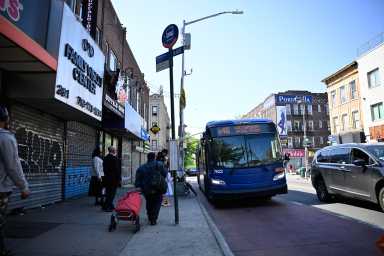MTA Bus and SUV Collide in Canarsie as Crash Rates Edge Down in 63rd Precinct

Even a small dip in traffic accidents in New York cannot quell concerns about persistent dangers to public transit and city streets alike.
It was the kind of night that only the most dedicated Brooklynites see: just after three in the morning, in the sleepy remnants of Canarsie, a Metropolitan Transportation Authority (MTA) bus thundered through a dimly lit intersection and collided with an SUV. The staccato of sirens shattered the stillness; two car occupants were rushed to Kings County Hospital, reportedly in stable condition. For a city where millions take to the streets by bus and car daily, such crashes, while no longer shocking, remain unsettling for those who rely on the city’s formidable, and sometimes fragile, transit system.
Details about this particular smash-up at Glenwood Road and Ralph Avenue, in the 63rd Precinct, remain scarce. The cause of the crash still eludes the NYPD, whose investigators sift through the detritus of crumpled metal for answers. Both vehicles—one the lumbering B47 bus charting its night route, the other a less robust SUV—were traversing the increasingly placid yet always unpredictable Brooklyn street grid.
Bus crashes are not mere curiosities in America’s largest metropolis. In fact, New York’s streets bear constant witness to risk: in 2024, there were 422 motor vehicle collisions reported in the 63rd Precinct alone. Year-to-date data for 2025 shows a tepid decrease, with 415 incidents—a mere blip, but one city officials quietly take as encouragement, at least for now.
Behind the numbers lie uncomfortable truths. New Yorkers, rarely short on opinions about public safety, note that the MTA’s roughly 5,800 buses and their drivers face a patchwork of traffic: aggressive rideshares, tired shift workers, and cyclists emboldened by fresh bike lanes. Each collision—particularly with a city bus—echoes anxieties about transit reliability, the safety of all-night service, and the hard limits of Vision Zero, City Hall’s much-touted plan to eliminate traffic deaths.
The immediate cost is paid in the form of bruises, twisted axles, and insurance paperwork. Yet the broader effect is a city that, even in marginal statistical improvement, struggles to feel credibly safer. For the borough-specific 63rd Precinct, the reduction of a mere seven incidents might offer solace to data analysts, but does little to change perceptions in Canarsie or among long-haul bus drivers eyeing every green light as a calculated risk.
Each collision radiates outwards. Beyond the two hospitalised passengers, fellow bus riders found their commutes abruptly scarred, MTA operations faced more scrutiny, and locals mulled over the accident as they waited for the next bus. Measured against the MTA’s massive daily ridership—some two million on the bus network alone—this singular event is mathematically paltry, yet for its participants, anything but. On the balance sheet of urban trust, such incidents carry outsized weight.
Public transit, for all its frustrations, is a sinew of urban life: nearly half of New Yorkers cannot afford private cars, and bus routes like the B47 are literal lifelines for working-class neighborhoods. Persistent accidents—no matter how modestly trending—threaten to erode confidence not just in the system’s safety, but its basic dependability. Less quantifiable, but no less real, is the anxiety lingering at curbsides and bus stops, nudging city dwellers toward more expensive, more polluting alternatives.
Buses, benchmarks, and broader lessons
To be sure, New York is hardly alone in its vehicular woes. Major cities from London to Los Angeles wrestle with similar challenges: larger vehicle fleets, congested roads, and shifting post-pandemic travel patterns have left officials with fewer easy fixes. Globally, cities measured as “transit rich” see safer outcomes, yet even in those cityscapes, crashes like Sunday’s Brooklyn collision are depressingly normal.
Any incident involving an MTA bus also ricochets through complex municipal priorities: do more cameras and stricter traffic enforcement bring measurable gains, or do they simply redistribute blame? New York’s gradual rollout of bus lane cameras and real-time tracking has portended modest improvements, but critics argue that reactive measures cannot compensate for systemic ills—aging infrastructure, distracted pedestrians, inconsistent driver training, and an urban metabolism that remains perennially over-caffeinated.
Localized data point toward the possibility of incremental progress. Advocates for Vision Zero—often dogged bureaucrats at the Department of Transportation—see slight dips in collisions as faint recognition that enforcement, education, and engineering can alter entrenched behavioral habits. Yet, for every small dip in the charts, there is an expectation that dramatic progress is just around the corner, an assumption which may not withstand the city’s ferocious complexity.
What, then, can New York glean from this latest nocturnal mishap? Certainly, it offers a predictable round of calls for deeper investigation, and perhaps, marginal lessons in driver awareness. Ultimately, however, it highlights the stubborn resilience of risk: in a city where mobility is a daily act of faith, “safe enough” remains the bureaucratic grail, rather than an existential promise.
That is not, strictly, a cause for alarm—nor, regrettably, for complacency. In urban life, the pursuit of zero, whether in crashes or casualties, is noble but likely Sisyphean, and even a handful fewer collisions should be recognised as a genuine, if tiny, victory. Indeed, the real test may be whether such episodes spur further, judicious investment in smarter roads, better oversight, and more reliable public dialogue about the costs and limits of transit-driven urbanity.
For now, Canarsie’s 3am quiet is shattered, then resumes, reminders of danger echoing only until the next headline. New Yorkers, shaped by exposure and necessity, will continue to heed the calculated risks of city living. We would do well to remember that progress here is neither spectacular nor linear—though, on balance, every downward tick counts. ■
Based on reporting from amNewYork; additional analysis and context by Borough Brief.